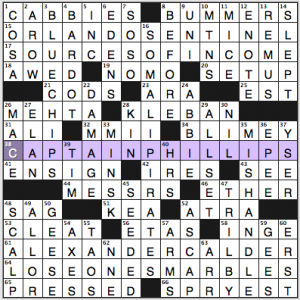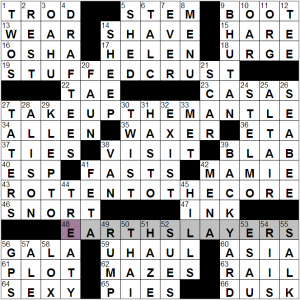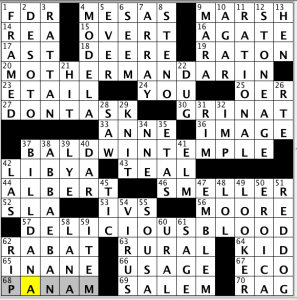NYT 4:12 (Amy)
LAT 5:38 (Gareth)
CS 6:01 (Dave)
WSJ (Friday) 10:31 (pannonica)
CHE 5:12 (pannonica)
David Kahn’s New York Times crossword
You know what I’m thinking? I’m thinking that double-stacked 15s flow a lot better than triple- or quadruple-stacked 15s. Who’s with me?
David Kahn gets a kick out of answers that interlock in a pretty way, and here we have a minitheme of related central answers: 38a. [See 16-Down], CAPTAIN PHILLIPS, and the 13-letter 16d. [Hijackers who captured 38-Across], SOMALI PIRATES.
The other 15s are the ORLANDO SENTINEL (a gimme for me), SOURCES OF INCOME, the great mobile sculptor ALEXANDER CALDER (ooh, I need to get over to the Museum of Contemporary Art this year for their Calder exhibit), and LOSE ONE’S MARBLES (a lot of ONE’Sies are flat but this one is fun). Other good fill includes CABBIES ([Those who respond to pickup lines?]) and BUMMERS in the top row (though the plurals don’t add value), BLIMEY, and BLUE CHIPS (another plural).
Really and truly did not know at all: 28a. [“A Chorus Line” lyricist Ed] KLEBAN. Never even seen that surname before, but I do know the Kliban cartoon cats.
Clue that I was just guessing at: 4d. [Actress for whom a neckline is named], BARDOT. I couldn’t tell you what sort of neckline that is.
Liked the clue for BEFORE: 8d. [First of two pictures].
Did not care for the ALL dupe (ALL SET, partial ALL OR), and even though we have twin 15s rather than triplets, we still have prosaic fill like ERST, YSER, EPEE, the dread E-NOTE, ARA, KEA, ATRA, ETAS/ARR, and INGE.
3.66 stars.
Joanne M. Sullivan’s Chronicle of Higher Education crossword, “Wold Series” — pannonica’s write-up
So I saw the title, and the first theme answer I completed was 27-across [Assume responsibility] TAKE UP THE MANTLE, and I groaned, making an assumption of my own. “Oh no. A baseball theme. Not only that, a Yankees baseball theme.”
But as the others developed I realized it was something else, confirmed by the revealing entry at 48a [The ends of 19, 27, and 43 Across] EARTH’S LAYERS (which is too easily misread in-grid as Earth slayers). The remaining two are 19a [Pizza Hut offering since 1995] STUFFED CRUST, and 43a [Thoroughly bad] ROTTEN TO THE CORE.
Two points of note. First, the layers are presented in order (a series, if you will), from outer to inner. If you care to quibble about the layers themselves—that there are distinct outer and inner cores, or that in a rheological analysis there is also an asthenosphere as well as a mesospheric mantle—that’s your prerogative, but the three are quite adequate for crossword purposes. Second, the senses of the words are essentially the same in both original phrase and repurposed extraction. Crust and core more literally than the metaphorical mantle, which nevertheless derives both etymologically and symbolically from the same root.
As for the non-theme fill, it’s mostly solid, without anything remarkably uplifting or volcanic. The longs are DRAFTEES and BACKYARD.
Seisms:
- Most noticeably clever bit: the back-to-back cluing of SNORT and INK in Row 11. [Pen sound] and [Pen filler]. See also, to a lesser extent, Row 8 with [What alumni do at homecoming] VISIT, [Tell tales out of school] BLAB, and [Connections] TIES.
- Also liked the side-by-side duo of twentieth-century heroes Jacob RIIS and Jonas SALK.
- The expected influx of Higher Education style clues and fill, including classical Greeks Homer and Aesop, the seven HILLS of Rome, Revolutionary War hero Ethan ALLEN and reference to John Trumbull’s painting of the signing of the Declaration of Independence, pianist VAN Cliburn, and more.
- Found the pitch of this trio of related items to be very uneven: 50d [Phuket native] THAI, 9d [Nation whose flag depicts a dragon] BHUTAN, 60a [Mekong River locale] ASIA.
- 66a [Active time for deer]. Since they’re crepuscular (assuming we’re discussing North American species), had to wait to see if it was DUSK or DAWN.
Good puzzle.
Randall J. Hartmann’s CrosSynergy / Washington Post crossword, “Apples and Oranges” – Dave Sullivan’s review
A phrase that typically refers to things that are divergent today leads us on a trip through an orchard and grove, pairing types of APPLES with ORANGES:
- [Dabbling duck with ducklings?] clued MOTHER MANDARIN – I’ve never heard of a Mother apple, but apparently they are from Massachusetts and “rated for their flavor.” Mandarin oranges are typically used in salads. Are mandarin ducks known for their superficial forays into hobbies? (rhetorical question alert)
- [The rite place for four acting brothers?] was BALDWIN TEMPLE – Baldwin apples are bright red winter apples, sweet and crisp for eating fresh or cooking. Temple oranges are Florida’s finest eating (cf. juice) orange.
- [Dracula’s delight?] clued DELICIOUS BLOOD – rather unsavory idea, but there are red and yellow delicious apples, and reddish-orange blood oranges.
Colorful and creative theme. A few “what the…?” moments in the fill for me, though. I have never heard of José Jiménez nor his “alter ego” BILL DANA. Reason why is that he was on the Steve Allen Show in the late 1950’s, just a bit before my time. SMELLER for [Schnozzola] makes some sense, but I’ve never heard someone’s nose referred to by what it can do. (Is a mouth sometimes referred to as a TASTER?) Anyway, rather appropriate to have the crossing LOOKER, which I suppose could’ve been clued as [Eye] on its own, but was [Eye candy] instead. RED DOG as a [Quarterback blitz] was also a new term to me; would Peyton Manning say that after “Omaha,” perhaps? (Probably not as it sounds like a defensive, not an offensive maneuver.)
Randolph Ross’ Wall Street Journal crossword, “Sloganeering” — pannonica’s write-up
Corporate advertising slogans, partially reëngineered.
- 23a. [Slogan for an auto or a golf tournament?] DRIVERS WANTED. Volkswagen.
- 32a. [Slogan for a chip or the CIA?] INTEL INSIDE. Intel. My favorite of the themers. Also—but only coincidentally—the only one to include the company name.
- 40a. [… for a coffee or parachute maker?] GOOD TO THE LAST DROP. Maxwell House.
- 68a. [… an antacid or Mariano Rivera?] HOW DO YOU SPELL RELIEF? Rolaids.
- 94a. [… a credit card or a pickpocket?] WHAT’S IN YOUR WALLET? Capital One.
- 106a. [… rental autos or hanging judges?] WE TRY HARDER. Avis. For hangmen, GOOD TO THE LAST DROP could also apply.
- 120a. [… a burger chain or a complaint department?] WHERE’S THE BEEF? Wendy’s.
Proud to report that I had to look up a few of these to identify the referenced entities. Also, some of these slogans are retired, or at least dormant. Nevertheless, they’re all iconic, memorable, et cetera.
- Partials of various configurations and presentations: LADY IN RED, I PLEDGE, OENO-, OOP, YES ON, I SHOT. Flimsy phrases: OLD CAR, SAD SONG, and to a lesser extent FOR FREE.
- Favorite clue: 28d [Took its toll?] PEALED. Runners-up: 48d [Orbit, for example] GUM, 128a [Conn man] STEERER, even though STEERER is not ideal fill (see also 82d PRYERS).
- Interesting diad: 104d [Goddess of wisdom] ATHENE, the less common (but my preferred) spelling / 115a [Cultural group] ETHNOS, a relatively uncommon word from Greek. Somewhat related: 67d [Goddess of the hunt] DIANA / 96d [Activity in which one takes a bow] ARCHERY (another great clue, by the way).
- Did not know 48a [Reflective opal] GIRASOL, which comes from the Italian for sunflower, and is also a name for Jerusalem artichoke, also called sunchoke, which is really a variety of sunflower. Also unfamiliar with OILCLOTHS in the sense of 84d [Cupboard shelf liners].
- With –––––GE in place, 22a [Act the marauder] was obviously (to me) BESIEGE. Bzzt! PILLAGE, which is a better fit.
- Favorite long non-theme fill: SUSHI ROLL, CALIBRATE.
- Clue That Did Not Work For Me: 60a [Green water] DEW. I get that green is meant in the sense of a lawn, but I still don’t care for it.
- After it was filled in, kept reading 103d [California-based sneaker brand] LA GEAR as “lag-ear”, reinforced by its proximity to 105d DEAFER. Also, it reminded me of lop-ear.
Cute puzzle, about average overall.
Paul Hunsberger’s Los Angeles Times crossword – Gareth’s review
I’m slightly ambivalent about today’s set of puns by Paul Hunsberger. The sound change emulates a common speech deficit, which I find gives it a stronger effect. The theme clues themselves are very evocative, another big plus. Saying all this, some of the parsing was “out there”, I’m still not exactly sure how FREEMENANDABABY answers [Guys with plenty of time for child care?]; [Like Barney with his pal?] for HANGINGBYAFRED requires one to suspend disbelief that one wouldn’t really say HANGINGWITHFRED – I guess that’s what makes it wacky. [Lament following an Elizabethan wardrobe malfunction?], THEFRILLISGONE is excellent though and [Got locked out of a Finnish sauna during winter?], FROZEINTHETOWEL is probably one of my favourite joke answers in recent memory! It paints an excellent mental picture that one! I guess I’d call these pun answers brave collectively, and consider two smash hits a better deal than “four meh but solid” answers.
Despite four long themers, Mr. Hunsberger has also graced us with a number of superlative non-theme answers: STARSONICE, HOTANDCOLD (crossing FROZEINTHETOWEL with its sauna clue!), the interesting letter patterns of MCMUFFIN and UVFILTER , and GLORYBE would all be top answers to be in any themeless grid! I also have an affinity for ANILINE , a chemical whose derivatives have many uses, including the world’s first synthetic dye – mauveine! There are some trade-offs for these: 3 partials (ATEM, ANERA and TALKA) one more than the official limit (which isn’t hard), and one or two bits of word detritus like UNE and TRA. Of the plurals, GIVENS looked strange at first, but considered in a mathematical context, it’s perfectly normal; ICINGS is also odd, but defensible. Lastly, I also didn’t know COLS as a word.
Any failings this puzzle did have were more than made up for by FROZEINTHETOWEL and the excellent long answers in my book! 4.25 Stars.
Gareth






An enjoyable Friday puzzle!
A lot of plurals in this one. I’m guessing/remembering that a BARDOT neckline is low, very low. Another dupe at SET UP & ALL SET.
Yay! For once, living in the Orlando area instead of New York helped me on the NYT crossword!
CHE World Series
Great fresh cluing right out of the gate: Pressed grapes, perhaps. Who else thought WINE? TROD’s first link with grapes, says CV database. Joanne M. Sullivan’s WAXER clue, Certain salon employee, evokes a heretofore unseen facet of a word clued only about floor polishers. Post-op feature: SCAR. Nice. All-over fun, a pleasure to solve, free of xwrdese, with lively fill & theme entries make it a solid 4 star puzzle in this solver’s book.
-sea
Lots more to like in the NYT: Well positioned = SEEDED, Simple sorts = GEESE, etc. I do wish we could quit fussing about the common fill and enjoy the the clever fun more fully!
Additional quasiminitheme tie-in for the NYT: 48a [Org. of which Tom Hanks is a member] SAG. Make of that what you will.
Never heard of a Bardot neckline and I’m a woman. Very enjoyable puzzle. Nice to hear from Calder and Bardot too. And no need to be a Floridian to know about the paper.
What is the tie-in with the Screen Actors Guild?
Just that Tom Hanks starred in the movie about the events in the central crossing.
Okay, girls, listen up. A Bardot neckline is a gentle curve from shoulder to shoulder, often with a fold, sometimes dipping lower in the back. It may slip off the shoulder, or not, depending on how tight it is. It reveals shoulders and necks, not bosom.
Why do I know this? I have no idea.
Oops! I should read all the posts before opening my big mouth.
BARDOT décolletage of yesteryear, illustrated:
http://24femmespersecond.wordpress.com/2013/08/24/brigitte-bardot-decolletage/
The Bardot neckline has a very wide neckline that exposes both…………………shoulders.
I thought this was very easy for a Friday. I have seen Captain Phillips (solid, but not great), so that gave me some footholds and only Sources of Income was tricky of the five 15’s.
Steve
Thrilled with this puzzle. Able to complete. First had tweet for enote but otherwise all went exceedingly well.
After I saw Captain Phillips I renewed my moratorium on historical fiction and biography, the “Based on a true story” genre. I’ve developed this inescapable and masochistic ritual of a post-viewing google of the veracity (or “historical accuracy”) of such a film.
Can’t help it. I watch Captain Phillips and when the credits roll I feel informed, I feel knowledgeable about the subject, I feel moved to go out into the world and converse intelligently on events that I now know something about. … Then I google and discover all the stuff that didn’t really happen. So I get mad and make another moratorium. People tell me there’s better things to rant about, wiser fights–that the potential for ethical cheesiness in Hollywood is nothing new and is something most moviegoers come to grips with, early on. I think a part of me died when I found out [SPOILER ALERT] filmmakers had fabricated the cool scene in A Beautiful Mind where John Nash (Russell Crowe) laid out the foundations of a new and revolutionary economic model based on men and women hooking up in a bar; and I should resent my own naivete, as I’d relayed that “story” ten times before I truth-googled it, more than I resent Hollywood, I know, but I just can’t Scully the acceptance for “that’s how it is” that it seems other cinephiles have: I Mulder it as fraud.
When the hot topic was James Frey’s copping to having fictionalized parts of A Million Little Pieces, I had more than several conversations in which I harangued about Frey’s cheesiness to which the typical response was, “So what? Who cares? A work of fiction occupying the Bestseller Nonfiction List is not that big a deal.” But when apprised that a particularly memorable and vivid scene in the book involving dentistry and an absence of painkillers never really happened, “Who cares?” became “That is cheesy. I feel lied to.”
They should make a movie about the historical accuracy of Captain Phillips. Interesting stuff. Why is Braveheart the perennial epitome of artistic-license abuse, when current examples abound? And actually they did make a movie-about-the-making-of-a-movie, recently, starring Tom Hanks. I watched it. Then I googled it. Omg. Then I watched Big. Twice.
Hear, hear. I was usually not one to negatively judge a “historical” film for taking dramatic liberties. Even many documentary films aren’t 100% accurate. But it was “Argo” that first really rubbed me the wrong way, and “Captain Phillips” evoked a similar emotion. At least with “Argo” it had entertainment value (though a laughable choice for Best Picture); “Captain Phillips” had a decent first hour but hit the skids in the second hour and I thought it was pretty boring overall. Then to read the blatant inaccuracies in the film made it that much worse.
The optimist in me says that seeing the movie can foster interest in the topic and viewers will read up on the topic. But in the 24-hour news cycle culture of today, a lot of folks just don’t have the attention span for that. The danger is that conspiracy theory garbage like “JFK” can become bible truth for those who don’t bother to actually do hard research in the topic. A sobering example of the power of the moving image.
http://xkcd.com/182/
I studied game theory in college. My adviser was Thomas Schelling. My favorite book was The Strategy of Conflict. I studied Nash and others. I thought A Beautiful Mind was a great movie. I knew from my studies that Nash was weirder (to put it delicately) than he was portrayed to be in the movie. Some critics thought that the sugar coating of Nash’s perversions spoiled the movie. I could not have disagreed more. Do we really need to be absolutely realistic?
Steve
Interesting discussion. I don’t watch movies expecting to find out what “really happened” (even some documentaries, which take their share of liberties). But especially not big-budget, star-driven dramas that are intended to entertain an audience. I guess I don’t get very upset when I find out the historical facts are not what I see on the screen.
The movies with Hanks (as Phillips and Disney) are hardly exceptions. Look at last year’s Best Picture nominees. Six films fall into the “based a true story” genre (American Hustle, Dallas Buyers Club, Philomena, 12 Years a Slave, The Wolf of Wall Street, and Captain Phillips). Only three are “original” stories (Gravity, Her, Nebraska). I think there may be a trend there, but do you think any of the “true stories” are really true?
I loved the notice at the beginning of “American Hustle,” David O. Russell’s take on the Abscam scandal: “Some of this actually happened.” Much more honest (and funnier) than saying “based on a true story.” Hollywood isn’t interested in history, but if they get people thinking it’s a true story, maybe that helps with marketing the film to an audience (and getting the budget okayed — no small thing).
That stretching of the facts wasn’t invented by Hollywood, though. Seen any Shakespeare lately? Richard III, Julius Caesar, etc. Do you think those characters and stories are true to life?
Storytellers have been making up stories forever. That’s what storytellers do. Should we talk about the Bible?
Hollywood filmmakers, like many before them, have choices to make. Do they tell a story that’s as entertaining and convincing as they can make it, or do they stick to the facts of what happened and risk boring the hell out of the audience?
Every time you see movie about a so-called true story, understand that much of what you see was invented for dramatic purposes. Don’t think it’s all “history.” Be more skeptical than that. But that doesn’t mean there aren’t truths to be found.
P.S. I haven’t read any James Frey, but what I understand he did is something very different than what we’re talking about here. He told lies about himself and tried to pass them off as true.
P.P.S. I agree with Andrew completely about Argo. It was interesting to see Zero Dark Thirty so mired in controversy about its treatment of some facts, especially about torture, in effect knocking it out of the running for BP, the same year that the much-fictionalized Argo won the Oscar.
P.P.P.S. I am a big fan of JFK, and I think Stone got unfairly maligned by many people who jumped on board a well-funded political campaign to discredit him. That’s not to say I think JFK is good history. The story in the movie doesn’t completely add up, and it’s not what I would say “really happened.” Stone threw everything into mix and he doesn’t leave you with a coherent version of all the facts of Kennedy assassination. But I don’t think that’s what he was trying to do (at least that’s not what I take from the film). The film takes issue with what the official story was, and if look at what the powers that be were selling as so-called history, you probably would say that that story doesn’t add up either. It’s not just moviemakers who make up stories.
Thanks for your thoughtful response John. I still laud “JFK” to this day for its exceptional – cutting-edge even (pun intended) – editing and cinematography. It really is notable work from a technical aspect. I’ve watched it many times and have been engrossed in it each time.
The theory as presented in the film (esp. the Donald Sutherland scenes) makes a lot of logical sense. There is no counterargument presented however, and Kennedy’s commitment to Vietnam is conveniently misrepresented to fit Stone’s theory. In this sense many viewers can be convinced that JFK was killed because he wanted to pull out of Vietnam, which I think is highly debatable at best and flat out incorrect at worst.
Haven’t seen the O Stone film, but I have read both the J Ellroy and D DeLillo books (American Tabloid and Libra, respectively). Does the film draw on either of those … interpretations?
I would say “JFK” is Stone at his filmmaking best, and it’s still a noble effort, but in the end it may have backfired in attempting to set the record straight. The prior debate had been whether the Warren Commission could be believed. Then the debate became whether Stone could be believed. Refuting one doesn’t prove the other, however, despite what some in the anti-Stone brigade may like to think.
Still, all these years (and Vincent Bugliosi) later, most polls show at best a quarter or third of the public believes the lone-gunman theory.
The Stone film was based mostly on “On the Trail of the Assassins,” by Jim Garrison (played by Kevin Costner), the D.A. in New Orleans during the ’60s. I read it many moons ago and thought it was interesting but not as compelling as some of the writings of Mark Lane. The narrative in the Garrison book was probably better suited for the movies, though.
I never read the Ellroy or DeLillo books, or Stephen King’s novel, for that matter.
(Earthquake in L.A. as I write this. 5.3-ish? Maybe time to change the subject….)
I don’t read King, even though some say he’s capable of being a good writer.
Given my interests and predilections, by far the most extreme, if not infuriating instance of the phenomenon you describe in your interesting post is Bernard Rose’s bio-pic about Beethoven, entitled “The Immortal Beloved.” The identity of the intended addressee of the incredibly passionate, undelivered love letter found among Beethoven’s papers after his death, is one of the great mysteries of the musical universe. It’s a topic I have researched painstakingly, in great detail (even laboriously working through other letters which have not been translated from the German to see if there are any clues to be picked up.) .
The answer will never be known, but there are pieces of concrete evidence which conclusively rule out some possibilities, and diminish the likelihood of others. The answer proposed by the movie — that she was Joanna Reiss, the wife of Beethoven’s Brother Kaspar — is nothing short of idiotic nonsense. Less bombastically, it can be conclusively rebutted by various forms of scientific analysis, combined with facts clearly known about Beethoven’s life. Beethoven and Joanna detested each other, by the way, and the movie makes a ridiculous attempt to parlay that into some sort of unconscious passion for her. Normally that would appeal to my contrarian instincts, but there is no a shred of plausibility to the conclusion, which is made even more ridiculous by the suggestion in the film that Joanna was pregnant with Karl by Ludwig, when she married Ludwig’s brother Kaspar, as the next best thing. In other words — Karl was Beethoven’s son, not his nephew. Total lunacy, which is unfortunate since, in my view, the movie contained some fine acting and was meritorious in some respects.
Is this a soap opera, or what? I think the strongest case can be made for Josephine von Brunsvick, who has taken the lead over Josephine’s sister Therese von Brunsvick, not to be confused with Therese Malfatti, another of Beethoven’s lady friends, who has also been suggested. That now seems unlikely, but it *is* clear that Therese Malfatti was the actual dedicatee of the piano piece known as Für Elise — that Beethoven’s title scrawl was misread. OK — TMI, but it’s a fascinating riddle, and what could have been a very good movie made me almost pathologically angry for its complete disregard for fact and reason.
No longer contemporary, but recommended. Written by someone who knows a thing or two about both history and fiction.

Pretty sure there have been some more recent books in the same vein.
Is this any different from “History of the World Part I”?
Yes, much.
No review of the LAT, yet. Did you oversleep, Garef?
I normally solve and blog straight after work. Things happened. Post is up now.
So impressed with you guys who know the Bardot neckline! It’s actually very flattering for women of all ages. It seemed to go out of style for a while but it’s back. My daughter showed up on Christmas morning wearing one, along with pearl earrings and hair softly pulled back– a retro look that I found surprisingly pretty (many retro looks seem out of place to me).
SAG is one of the least fortunate acronyms ever. Surprised it came out of Hollywood. Some plastic surgery is required.